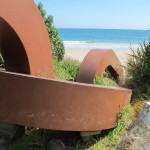
Maui, half-man and half-god, is credited in Maori legends with many great feats. He lengthened the day by subduing the sun and slowing its progress through the sky. And he created the land of New Zealand by anchoring his canoe, which became the South Island, then catching a great fish, which became the North Island. The anchor that steadied him was Stewart Island, the largest of the country’s offshore islands, about 650 square miles in size.
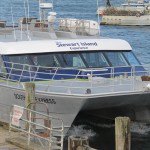
The islands are mostly secure today (though rocked regularly by earthquakes), but you can take a battering when you cross the Faveaux Strait that separates Maui’s anchor and canoe. The relatively shallow waters are frequently stormy and whipped up by strong westerly winds. When we travelled to Stewart, we hadn’t seen such waves since we did the notoriously wild Drake Passage to Antarctica. Yet conditions change quickly: the return trip was quiet and smooth. The catamarans used to ferry people to the island are designed specifically for the worst potential of this 16 mile passage.

Making a living on Stewart Island has mainly depended on the sea. In the past, whaling and sealing attracted Norwegians and other foreigners to that hard life, but those days are gone. However, the seas here remain rich in marine life, and yield a bountiful catch of highly prized seafood. They may not fish as Maui did, but the work is as challenging as ever, with long hours and dangerous sea conditions to weather.
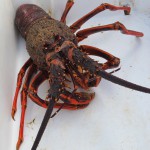
Some of the most valuable catch is crayfish, the local version of lobster. The season lasts only a few months, but the hard labor of the work can cover a year’s livelihood, as one long-term resident and crayfisher told us, while we gorged on the chewy crayfish meat. Others catch the abundant finny fish, notable the succulent blue cod, destined for many foreign markets. The somewhat more sedate industry of salmon farming has also grown recently.
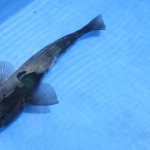
In these waters, locals also farm mussels, which are packaged and shipped around the Pacific. Even better known are oysters taken from the rich natural beds here. They’re known as Bluff oysters, for the main processing town just across the Foveaux strait. The oysters are distinctive. Each of the dozen we had offered three layers of taste and texture: there’s the typical jelly-like portion with its fresh lightly salt taste, then a more fleshy orangey portion for a rich tang on the tongue when chewed, then finally a slightly bitter juice on the palate to complete the experience. If oysters be the food of love, we will have surfeit of it.
The oddest catch is not directly from the sea, but what eats from the sea. Mutton birds, or more formally sooty shearwaters, have nested here for eons, providing a traditional food source for the local Maori. They alone still have the right to do muttonbirding. During the several month-long season they will gather their families, take the children out of school, and move into shacks on the small nesting islands. There they laboriously catch small to medium size chicks, which are cleaned then bagged in salt and fat to preserve them. Apparently the taste is unique, like moldy fish and fat together, someone told us; sadly we did not have a chance to try it.
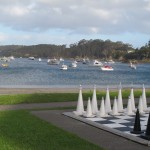
We were part of the catch for the most recent industry here, tourism. The island – and its only town, Oban – hosts people who want to get away to an extraordinary natural environment. There’s not much else: one shop, one grocery store, and one movie house showing a delightful film celebrating the history and often quirky people of the island. But it’s the nature that draws us here.
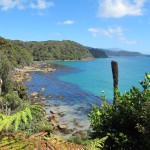
Backpackers and hiking zealots make the pilgrimage to circle the island for three days on the beautiful 37 kilometer Rakiura Track, one of the nine Great Walks in New Zealand.
We did several day walks on the track including the long, shell-strewn crescents of Maori Beach and Lee Bay and the steep observation point of Garden Mound. Local boat owners can take you to other spots on the island if you wish to see more remote places for a day.
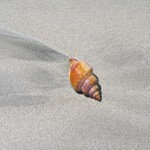
Birders also flock here so they can wake to the endless bird song on the main island or move alertly on the trails of Ulva Island. Now freed of predators, like Kapiti Island near Wellington, Ulva is a unique place to see and hear many of New Zealand’s native species in the wild.
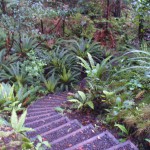
We spent an afternoon on the short trails, enjoying the dense rain forest and finding plentiful birds, at least until a squall dampened both our enthusiasm and the birds’ activity.

The island resident that ferries people back and forth advises you to stop on the trail and wait patiently, for “the birds will come up to you and look around.”
And you can see kiwis. Among a few other locals, Phil and Diane lead a nightly kiwi spotting expedition on a narrow neck of beach about 45 minutes boat ride from Oban. Our pleasant evening trip passed little blue penguins, a rare yellow-eyed penguin, plenty of mutton birds, and a colorful sunset.
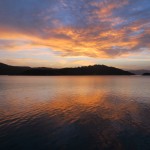
Then, single file, flashlight/torch in hand, we plodded over an easy trail through the bush. On the beach, as things darkened, our guide swept his flashlight along the sand to find kiwis. “We’ve had a 100% hit rate for these expeditions,” he had said earlier, as we passed the wooden carving of a kiwi on the dock. Now on the beach, he added, “Don’t worry; sometimes we have to go up and down the beach a few times: then maybe we’ll see one, or maybe as many as five…you never know.”

A bit anxious and concerned whether we would see anything, we trudged in his wake, the triangle of his torch sweeping back and forth ahead of us. Then, he turned and whispered to us of a successful find. There she was, a female kiwi calmly picking at bugs deep in the sand, placidly indifferent to our presence or the bit of light upon it. She looked like a big ball of feathers on thick sticks, out of which a remarkably long neck snaked and stretched, so that her long bright beak could probe into the ground. When she walked, she appeared to be falling face first into the ground, held erect only by those strong legs.
She departed shortly, and then we located a few more, including one skittish young male who did not linger like the others and demonstrated the remarkable speed of this apparently ungainly bird. The satisfying finish was seeing another large female just by the trail on the way back out. Who knew a ball of fuzz could be so sexy!

Of course, the life of the ocean is an attraction as well. One excursion took us out to the nearby Titi islands. We visited the seal colonies on them, found more yellow-eyed penguins along the shores, and even caught – and released – a few of the yummy blue cod in these waters. White Capped Albatrosses sailed in the boat’s wake.
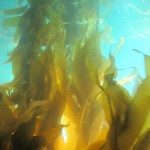
You can also go below the surface in the comfort of a semi-submersible vessel whose glass-enclosed chamber shows off passing fish – banded wrasse, mokis, trumpeters and more – plus startling varieties of seaweed.
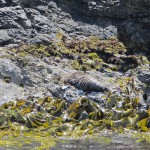
In all these activities, you can tell from the enthusiasm of the locals that what they do is not just work. They too are turned on by the magnificent life and landscape around them. Even the pilots accompany you into the glass chamber to see what fish are around. Burly, weathered fishermen discourse on the ways of the kaka parrot. They are committed to stewardship, maintaining the beauty of the land they live on and sustaining the rich marine life they catch.
Stuck on an island for a large part of the year, fighting the weather and seas to make a living, even wrangling tourists,, many locals turn become a bit salty and quirky too. One resident we met lives amid thousands of books, new and old, and loves to read the yellowing pages of old American western novels. Another couple prefers American country and western music while entertaining, encouraging all to dance. There’s a chef from the Czech Republic who subs as bartender and stays amused by adding international dishes like curries to the menu.

Then there’s Vicki, who emcees quiz night at the South Sea Hotel. Though regulars sometimes match her barbs, Vicki mostly rules the evening like a dominatrix. If you make too much noise, she will duct tape your mouth. If you question her judgments, she curses you vigorously. She turns the formulaic process of quizzing into performance art, holding roughly 60 people under her spell for two hours. She browbeat one couple from Arizona into participating, though all they wanted was a quiet dinner, but by the end they were happy she did.

Even plans for the island’s future can turn a bit off-kilter. A local official recently tried to drum up interest in turning all of Stewart Island into a wildlife sanctuary. That meant removing all predators, just as the Department of Conservation has done on the tiny islands of Ulva and Kapiti. That effort, he reckoned, would attract 100 times the current level of backpackers, trekkers, hiking zealots and lovers of marine worlds. The idea was crackers. Those two islands together are about 1% the size of Stewart and required years of costly predator removal work…and they attract only a few tourists.
But his proposition, even if wholly impractical, does fit both the people who live here and those who visit. For them, it’s all about the bounteous nature.
(Also, for more pictures from New Zealand, CLICK HERE to view the slideshow at the end of the New Zealand itinerary page.)


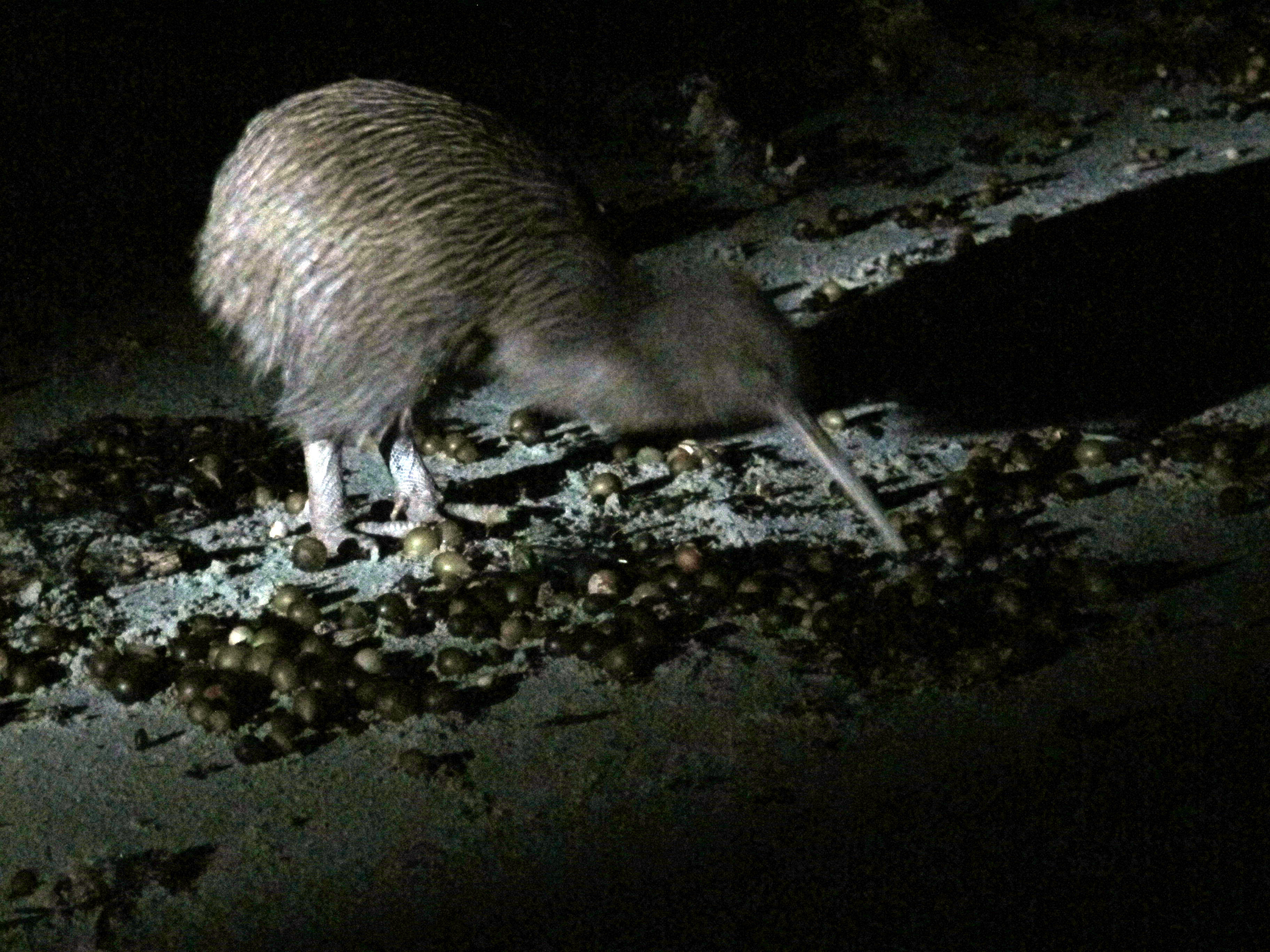
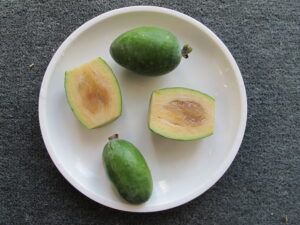
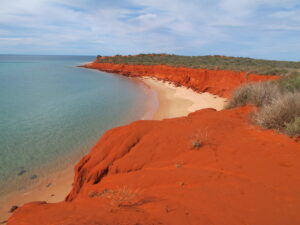
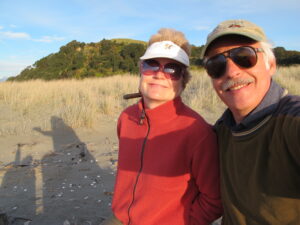
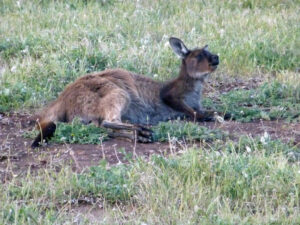
Why does vicki have a hitler mustashe?
You’ve heard of the soup Nazi? Well, apparently the locals consider her the Quiz Nazi…with duct tape.
Mwahaha, stumbled on this through Jo’s facebook page! Thanks guys, lovely write-up!
Hey, Vicki! So glad you caught the article; I’m glad I kept the language clean (unlike quiz night, of course). You are the best, and we’re not just saying that to get extra points when we show up again. Have a great year in 2013.
Nice write up on our Island. Glad you enjoyed your stay and got to do so much.
Appreciate your comment and your island. We always do keep a busy schedule, but also had time to relax, enjoy ourselves and meet a lot of great people while there.